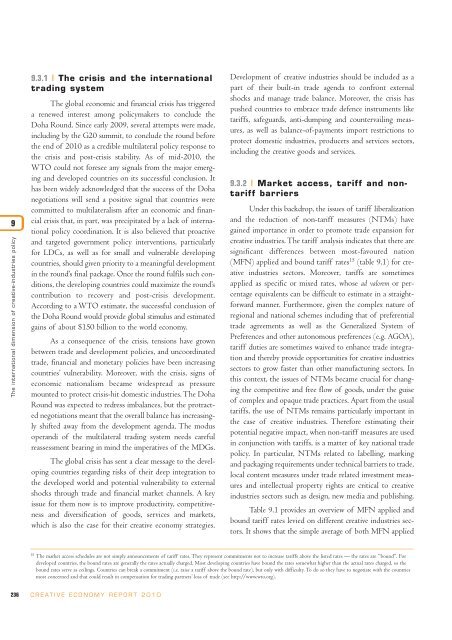Creative Economy: A Feasible Development Option
Creative Economy: A Feasible Development Option
Creative Economy: A Feasible Development Option
- No tags were found...
You also want an ePaper? Increase the reach of your titles
YUMPU automatically turns print PDFs into web optimized ePapers that Google loves.
9The international dimension of creative-industries policy9.3.1 The crisis and the internationaltrading systemThe global economic and financial crisis has triggereda renewed interest among policymakers to conclude theDoha Round. Since early 2009, several attempts were made,including by the G20 summit, to conclude the round beforethe end of 2010 as a credible multilateral policy response tothe crisis and post-crisis stability. As of mid-2010, theWTO could not foresee any signals from the major emergingand developed countries on its successful conclusion. Ithas been widely acknowledged that the success of the Dohanegotiations will send a positive signal that countries werecommitted to multilateralism after an economic and financialcrisis that, in part, was precipitated by a lack of internationalpolicy coordination. It is also believed that proactiveand targeted government policy interventions, particularlyfor LDCs, as well as for small and vulnerable developingcountries, should given priority to a meaningful developmentin the round’s final package. Once the round fulfils such conditions,the developing countries could maximize the round’scontribution to recovery and post-crisis development.According to a WTO estimate, the successful conclusion ofthe Doha Round would provide global stimulus and estimatedgains of about $150 billion to the world economy.As a consequence of the crisis, tensions have grownbetween trade and development policies, and uncoordinatedtrade, financial and monetary policies have been increasingcountries’ vulnerability. Moreover, with the crisis, signs ofeconomic nationalism became widespread as pressuremounted to protect crisis-hit domestic industries. The DohaRound was expected to redress imbalances, but the protractednegotiations meant that the overall balance has increasinglyshifted away from the development agenda. The modusoperandi of the multilateral trading system needs carefulreassessment bearing in mind the imperatives of the MDGs.The global crisis has sent a clear message to the developingcountries regarding risks of their deep integration tothe developed world and potential vulnerability to externalshocks through trade and financial market channels. A keyissue for them now is to improve productivity, competitivenessand diversification of goods, services and markets,which is also the case for their creative economy strategies.<strong>Development</strong> of creative industries should be included as apart of their built-in trade agenda to confront externalshocks and manage trade balance. Moreover, the crisis haspushed countries to embrace trade defence instruments liketariffs, safeguards, anti-dumping and countervailing measures,as well as balance-of-payments import restrictions toprotect domestic industries, producers and services sectors,including the creative goods and services.9.3.2 Market access, tariff and nontariffbarriersUnder this backdrop, the issues of tariff liberalizationand the reduction of non-tariff measures (NTMs) havegained importance in order to promote trade expansion forcreative industries. The tariff analysis indicates that there aresignificant differences between most-favoured nation(MFN) applied and bound tariff rates 15 (table 9.1) for creativeindustries sectors. Moreover, tariffs are sometimesapplied as specific or mixed rates, whose ad valorem or percentageequivalents can be difficult to estimate in a straightforwardmanner. Furthermore, given the complex nature ofregional and national schemes including that of preferentialtrade agreements as well as the Generalized System ofPreferences and other autonomous preferences (e.g. AGOA),tariff duties are sometimes waived to enhance trade integrationand thereby provide opportunities for creative industriessectors to grow faster than other manufacturing sectors. Inthis context, the issues of NTMs became crucial for changingthe competitive and free flow of goods, under the guiseof complex and opaque trade practices. Apart from the usualtariffs, the use of NTMs remains particularly important inthe case of creative industries. Therefore estimating theirpotential negative impact, when non-tariff measures are usedin conjunction with tariffs, is a matter of key national tradepolicy. In particular, NTMs related to labelling, markingand packaging requirements under technical barriers to trade,local content measures under trade related investment measuresand intellectual property rights are critical to creativeindustries sectors such as design, new media and publishing.Table 9.1 provides an overview of MFN applied andbound tariff rates levied on different creative industries sectors.It shows that the simple average of both MFN applied15 The market access schedules are not simply announcements of tariff rates. They represent commitments not to increase tariffs above the listed rates — the rates are “bound”. Fordeveloped countries, the bound rates are generally the rates actually charged. Most developing countries have bound the rates somewhat higher than the actual rates charged, so thebound rates serve as ceilings. Countries can break a commitment (i.e. raise a tariff above the bound rate), but only with difficulty. To do so they have to negotiate with the countriesmost concerned and that could result in compensation for trading partners’ loss of trade (see http://www.wto.org).236 CREATIVE ECONOMY REPORT 2010
















